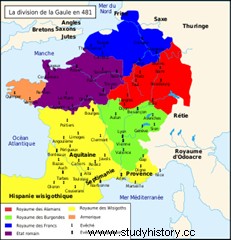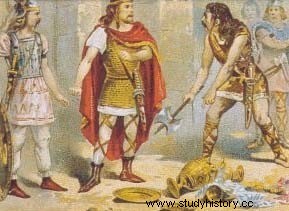 Clovis I , king of the Franks from 482 to 511 , is the most illustrious Merovingian . At the turn of the 5th and 6th centuries, this grandson of the legendary king Mérovée seized almost all of Roman Gaul. To consolidate his authority over his immense domain, he cleverly made an alliance with the Roman Catholic Church, the only institution to have survived the fall of the Western Roman Empire. Around 498, he converted to Christianity with several thousand of his warriors. Putting the conquering Franks and the Gallo-Romans on an equal footing, Clovis made these two peoples a single nation:the Regnum francorum , the kingdom of the Franks. The history of the francs , written a century later by Grégoire de Tours , is one of the few sources on the reign of Clovis that we have.
Clovis I , king of the Franks from 482 to 511 , is the most illustrious Merovingian . At the turn of the 5th and 6th centuries, this grandson of the legendary king Mérovée seized almost all of Roman Gaul. To consolidate his authority over his immense domain, he cleverly made an alliance with the Roman Catholic Church, the only institution to have survived the fall of the Western Roman Empire. Around 498, he converted to Christianity with several thousand of his warriors. Putting the conquering Franks and the Gallo-Romans on an equal footing, Clovis made these two peoples a single nation:the Regnum francorum , the kingdom of the Franks. The history of the francs , written a century later by Grégoire de Tours , is one of the few sources on the reign of Clovis that we have.
Gaul before the reign of Clovis
The end of the Western Roman Empire in 476 has long marked the beginning of the Middle Ages in historiography. However, we know today that the transition was much longer, and the changes complex, far from the cliché of the "barbarian invasions" that would have swept Rome in a few decades.
 The so-called "barbarian" peoples have been established in the Empire for a long time already, to varying degrees and in forms various. Historiography today speaks of ethnogenesis to explain the "fusion" between the Gallo-Roman population and the Barbarians. The latter, when they enter Gaul in the 5th century, are already familiar with Roman civilization, with which they will create new peoples. Germanic peoples are present in Gaul from the beginning of the 5th century, following the heavy problems experienced by the Empire at that time (sack of Rome in 410, etc.). The Visigoths crossed it to settle in Aquitaine and Spain.
The so-called "barbarian" peoples have been established in the Empire for a long time already, to varying degrees and in forms various. Historiography today speaks of ethnogenesis to explain the "fusion" between the Gallo-Roman population and the Barbarians. The latter, when they enter Gaul in the 5th century, are already familiar with Roman civilization, with which they will create new peoples. Germanic peoples are present in Gaul from the beginning of the 5th century, following the heavy problems experienced by the Empire at that time (sack of Rome in 410, etc.). The Visigoths crossed it to settle in Aquitaine and Spain.
Then it was the Burgundians who settled around Lyon and Geneva. Those who were only beginning to be called "Franks" at the end of the century (in particular the future "Salians"), for their part, crossed the Rhine and appeared in Gaul a little later, despite the ephemeral capture of Cambrai by King Clodion; they are thus repelled by the master of the militia Aetius and the future emperor Majorien in 448. This allows all the same to get to know the Franks a little, their king Clodion therefore, his son Merovée and the son of the latter Childeric I. However, it would seem that there were many other Frankish kings and that none of them succeeded in unifying the different Frankish peoples, until Clovis. This prevents them from progressing south for a long time.
It must be emphasized that these peoples ended up settling permanently, and that their relations with the Gallo-Romans were far from bad. In addition, their leaders sign treaties with Rome, or with local Roman generals, increasingly independent of the imperial central power. All of them, Gallo-Romans and "federated" Barbarians, defend Gaul against the threat of the Huns of Attila, defeated in 451 at the Champs Catalauniques.
Twenty-five years later, the fall of Romulus Augustule ultimately had few direct consequences for Gaul. It is then divided between, in the South, the powerful Visigothic kingdom which extends from Spain to the Loire; to the east, along the Rhône, the Burgundians; all to the North, on each side of the Meuse, Salian Franks and Rhenish Franks. Finally, stuck in the middle, between the Loire and Soissons, a "Roman royalty" led by Syagrius. It is the latter that Clovis will face.
The first conquests of Clovis
Clovis is the son of Childeric and a Thuringian princess, Basina. When he succeeded his father in 482 (or 481), the king of the Salian francs had to assert himself like any barbarian leader against his rivals. The best way is obviously conquest. He was not bothered by the Rhinelanders, who were too busy with the Alamans, but on the other hand we do not really know how the Frankish king dismissed the others, in particular the powerful Saliens established near Cambrai. In any case, Clovis manages to organize himself to attack the Somme valley fairly quickly after his advent.
Syagrius descends from an illustrious Gaulish family. Around 480, his kingdom included the countries between the Loire and the Somme, and included the town of Soissons. It is heavily romanized, which bothers Clovis who wishes to delete it. Supported by the Romans, Syagrius raises some troops to repel the Salian Franks. But Clovis defeated Syagrius at Soissons around 486, and the Roman leader had to take refuge with the Visigoths of Alaric II (who handed him over to the Franks shortly after). It was during the famous episode of the "vase of Soissons" that Clovis asserted his authority, but also announced his future rapprochement with the Gallic Church.
The Soissons vase episode
After his victory at Soissons, Clovis cannot prevent his troops from looting the surroundings and the churches. The loot is collected before being distributed to all the warriors. The sharing must be equal, everyone receiving the same thing, whether he is a leader or a simple soldier. Each of the shares is drawn by lot, including that of the king. A delegation from the Bishop of Soissons comes to ask for the recovery of a magnificent silver vase, from one of the devastated churches. This object is heavy and of great beauty. Clovis would have hoped to obtain it but does not succeed. The partition not having attributed the vase to him, Clovis asks the soldier who received it. He refuses and hits the vase with his axe.
 It is often believed that this blow broke the vase, when it only deformed it. Clovis does not react to this provocation since equal sharing is part of the contract between the chief and his men. However, the following year, he reviews his troops and finds himself face to face with the man who refused him the vase. Pretexting the poor holding of his weapons, Clovis tears the ax from his belt and throws it on the ground. The soldier then bends down to pick it up and Clovis smashes his head while pronouncing these well-known words:“Thus did you do with the Soissons vase! He then orders his troops to move away and leaves the poor man unburied.
It is often believed that this blow broke the vase, when it only deformed it. Clovis does not react to this provocation since equal sharing is part of the contract between the chief and his men. However, the following year, he reviews his troops and finds himself face to face with the man who refused him the vase. Pretexting the poor holding of his weapons, Clovis tears the ax from his belt and throws it on the ground. The soldier then bends down to pick it up and Clovis smashes his head while pronouncing these well-known words:“Thus did you do with the Soissons vase! He then orders his troops to move away and leaves the poor man unburied.
This event presents Clovis as a resentful man, furious at having been humiliated during the sharing in Soissons. However, his status as a warlord is highlighted by the review of the troops. The dress of the soldiers is important for the Franks, but also for the Romans, which is why the troops are reviewed once a year. Moreover, based on the Roman rules of his army, Clovis has the right to life and death over his men. He must eliminate the unruly warriors so that the others will be completely devoted to him.
It is therefore wrong to attribute to Clovis an image of an omnipotent king because even when he exercises his revenge, he respects military discipline. This story also shows the relationship between Clovis and the clergy. The care that Clovis takes to return the vase to the delegation and his dissatisfaction with the looting exercised on the churches express his need to ensure the good graces of the Church.
Clovis, diplomat and warrior
Clovis begins a great policy of alliance with the powers of the region, in particular the Ostrogoth Théodoric, to whom he marries his sister Audoflède. He even goes further by forging ties with the Eastern Roman emperors Zeno, then Anastasius, of whom he wants to be a legitimate representative. It was at the same time that he married Clotilde, niece of the King of Burgundy.
Around 500, dynastic quarrels gave him the opportunity to intervene in the neighboring Burgundian kingdom. The Burgundian King Gondebaud has eliminated Queen Clotilde's entire family. Defeated near Dijon, besieged in Avignon, he had to resign himself to paying tribute to Clovis and became his vassal. The Frankish sovereign continued his conquests:at the turn of the 6th century, he pushed aside the Alamanni at the battle of Tolbiac, and took advantage of this to subjugate the Rhenish Franks.
Then he turned to his great southern rivals, the Visigoths; he must then calm his ardor in front of the threats of Theodoric, recently allied to Alaric II. It was only a postponement:in 507, allied with the Burgundians, he attacked the Visigoth kingdom and defeated Alaric II at Vouillé. This decisive victory, where his rival dies, allows him to reach Toulouse. thereafter, Clovis seizes Aquitaine. At the same time, to counter the expansion of the Franc, the Ostrogoth Théodoric got his hands on Provence. In 508, Clovis was officially recognized by the Emperor Anastasius who made him consul, further proof of the close ties between the Barbarians and the Empire...
The consolidation of the Frankish kingdom
His territory having expanded considerably, Clovis must organize it to better control it. He settled in Paris, which he made his capital (around 508), in particular because of the links between Saint Geneviève and her father Childeric. This does not prevent what is not yet called the court from remaining itinerant long after. In an authoritarian, even violent way, Clovis dismisses all his rivals, including within his family. He executed the king of the Ripuarian Franks, then that of Cambrai, unifying all the Frankish tribes. Towards the end of his reign, he controlled three-quarters of Gaul, and only the Rhone Valley and the Mediterranean facade escaped his control.

As far as populations are concerned, he leaves their legislation to the Gallo-Romans, while the Germanic peoples present there also keep the rules imposed by Rome on their allies in Gaul. In the same logic, the Franks, whether they were Salians or Rhenish, also kept the Salic law and their traditions.
The baptism of Clovis and his warriors by the bishop of Reims Remi on December 25 (probably after 500) allows him to be confirmed with the support of the bishops of Gaul . In this area, Clovis respects the imperial tradition, and convenes a council in Orleans shortly before his death. The emperor, in line with Constantine, remains the one who dictates the canons of the Church. On the other hand, the Frankish episcopate is already beginning to claim relative autonomy in certain areas.
The sons of Clovis, the first "kings of the Franks"
Clovis died on November 27, 511. The first "rex francorum" , a title taken up by his successors, is buried in the abbey of Sainte-Geneviève in Paris (on the current site of the Lycée Henri-IV). In any case, the succession is not easy. Under pressure from Clotilde, who refuses that Thierry, who is not her son, be the only successor of Clovis, the immense kingdom of the latter is shared between Childebert (now Normandy, up to Paris), Clotaire (the North of Gaul), Clodomir (the Loire Valley) and therefore Thierry (the Rhine region). The fate of Aquitaine is more vague, because its situation quickly became complicated after its conquest.
This division did not affect Frankish power over Gaul. On the contrary, the expansion will continue…
Bibliography
- G. Bührer-Thierry, C. Mériaux, La France before France (481-888) , Belin, 2010.
- From Georges Bordonove, Clovis and the Merovingians. Pygmalion, 2009
- The History of the Frankish Kings, from Saint Gregory of Tours. Folio History, 2011.
